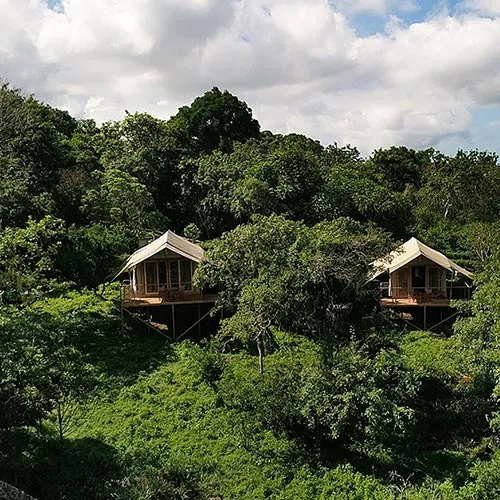Is January a good time to visit the Galapagos Islands?
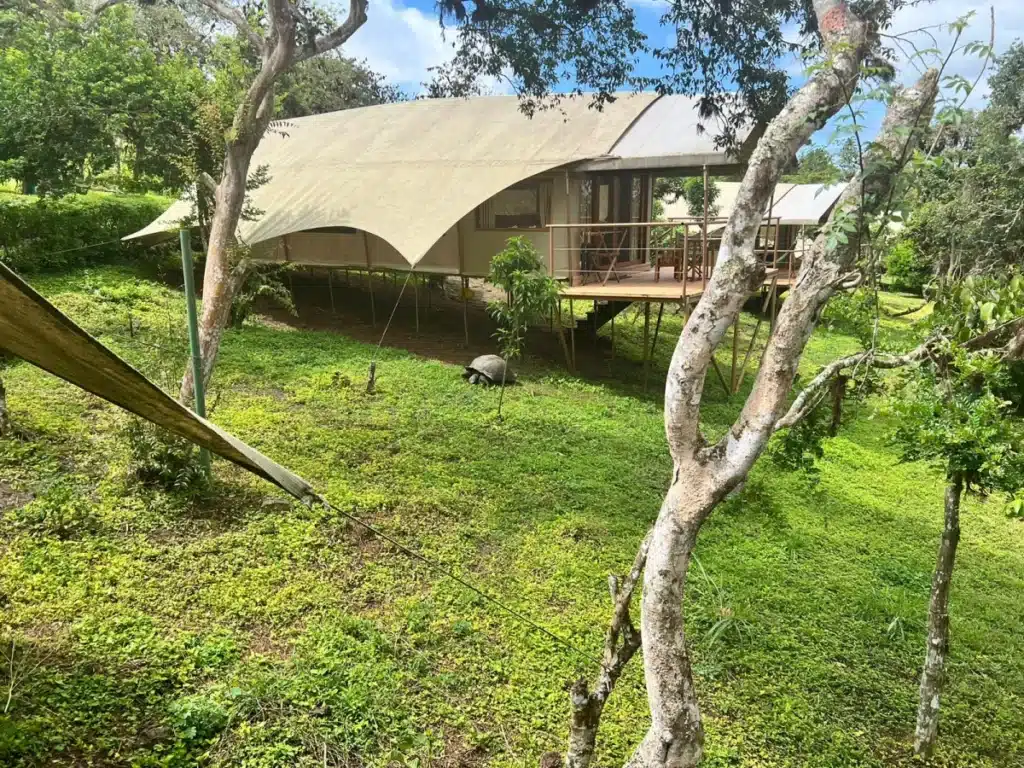
Galapagos Safari Camp in January
Peak Season:
January is part of the peak travel season in the Galapagos, thanks to the appealing weather and the start of the new year holiday period. Due to its popularity, it’s advisable to book your trip well in advance to secure your spot on a wildlife Safari.
Photos from January
All the photos in this article were taken during the month of January, either at Galapagos Safari Camp or on one of our Safaris.
Galapagos in January: At a glance
- Start of the Warm & Wet Season
- Mating season for many animals
- Air temperature: 22-31°C / 71-88°F
- Sea temperature: 74-76°C / 23-24°C
- Average rainfall: 2-5cm / 0.75-2in
- Clear skies: 4-7 hours
- Intermittent rain showers
- Wind force: 1-4
- Underwater visibility: approx 10-30m
Galapagos Weather in January
The month of January usually marks the start of the Warm & Wet season in the Galapagos Islands with average temperatures ranging from 22-31°C / 71-88°F,
Ocean currents
The southern trade winds ease, and the Panama current brings warmer waters to the islands from the northeast, making water-based activities such as snorkeling and scuba-diving more comfortable. Underwater visibility is also good, and the seas are calmer, making boat navigations more comfortable as well.
Rainfall
While January marks the beginning of the rainy season, the rain is typically short-lived and does not disrupt activities significantly. The showers often come in the late afternoon or evening, leaving most of the day sunny and pleasant.
Increased humidity
An increase in air humidity is also to be expected, especially on the coast.
Galapagos Wildlife in January
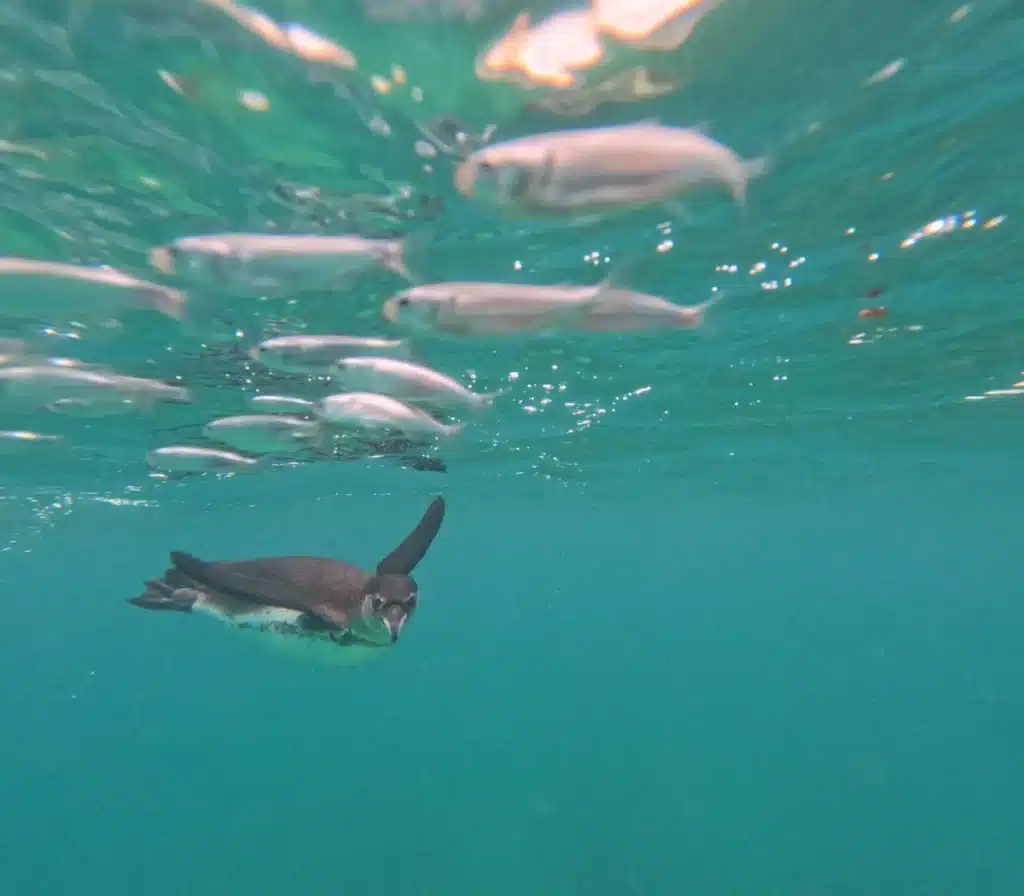
Galapagos Penguin, captured by a guest in January
In January, during the Warm & Wet Season in the Galapagos Islands, you can expect to see a vibrant and active wildlife scene, including:
Birds and Insects
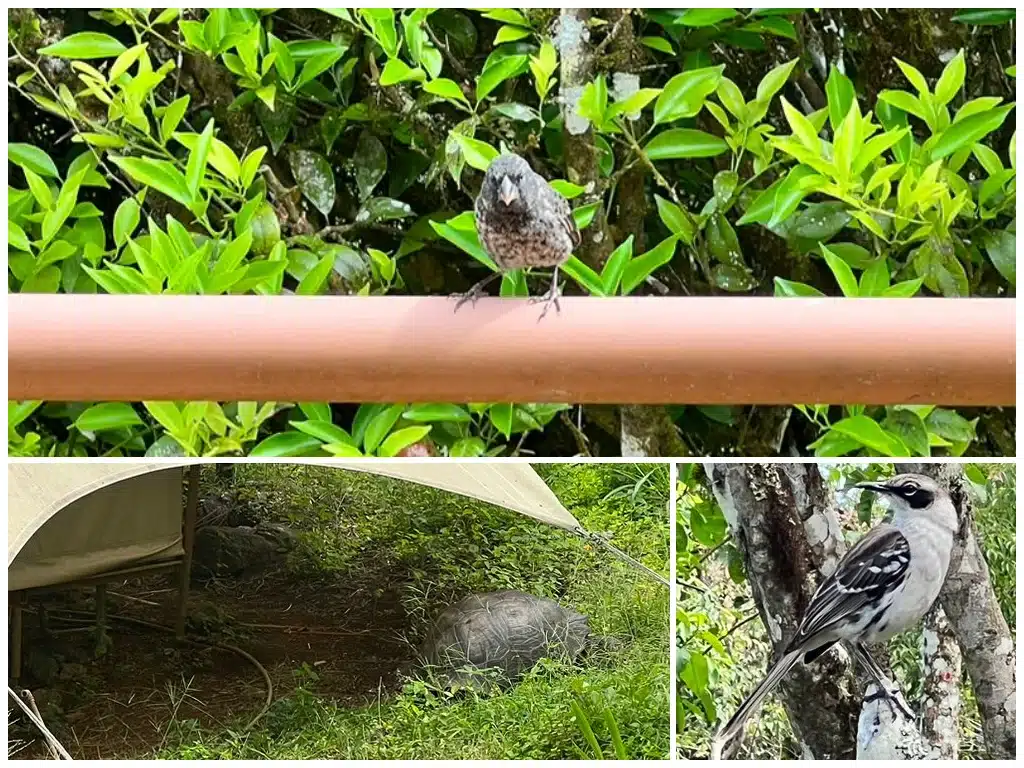
Galapagos finch (top) Galapagos mockingbird (bottom right), and a giant tortoise (bottom left) – all regulars at Galapagos Safari Camp
The beginning of the wet season brings about blooming vegetation, which in turn supports a richer bird population and insect activity. Birds start nesting and singing, looking for mates as the food chain begins to flourish with the rains.
Iguanas
Like the birds, Land iguanas also become more visible as they prepare for mating, with fights often breaking out between the males.
The increased humidity and occasional rains prompt more activity among these species, as they anticipate the availability of more food resources.
Sea Lions
This is a significant period for sea lions, as they can be seen engaging in various activities, including intensive diving for food. Newborn pups may also be observed, given that the breeding season is wide-ranging and pups can be born throughout the year, with a higher concentration of births around October and November. Nevertheless, January can still offer sightings of very young pups alongside their mothers.
Green turtles
Green turtles start laying their eggs, although this activity usually takes place at night, when the National Park is closed to visitors.
The nesting process itself is quite methodical and can take several hours. A female turtle will select a spot on the beach, often returning to the beach where she was born (natal beach), to dig a hole using her hind flippers. She then lays her eggs, which can number from a few dozen to over a hundred, depending on the species. After laying her eggs, she covers the nest with sand to camouflage it from predators and returns to the ocean. The eggs incubate for about 50-70 days before the hatchlings emerge and make their way to the sea, usually also under the cover of darkness to increase their chances of survival.
Other species:
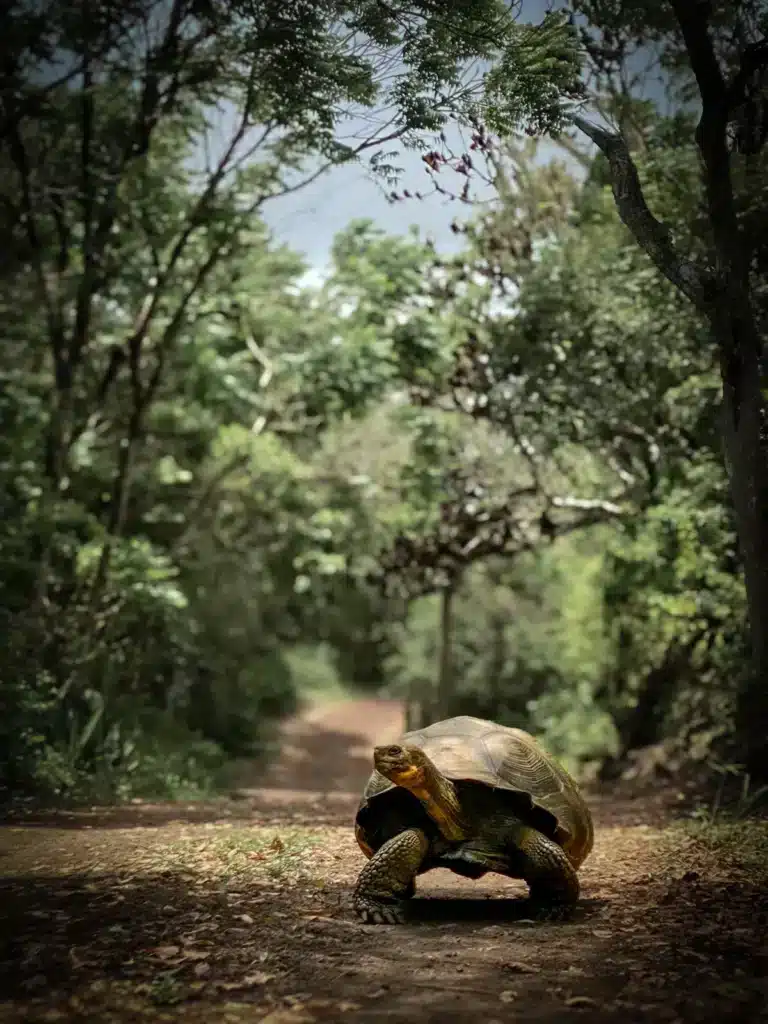
A Galapagos giant tortoise shuffles along the driveway of Galapagos Safari Camp (taken in January)
Species frequently spotted on our Safaris during January include:
- Giant tortoise
- Blue-footed booby
- Brown pelican
- Frigatebird
- Galapagos Dove
- Galapagos Finch
- Galapagos Mockingbird
- Galapagos Penguin (Bartolome Island, Isabela Island)
Read more: Galapagos Wildlife
Galapagos Safari Camp in January
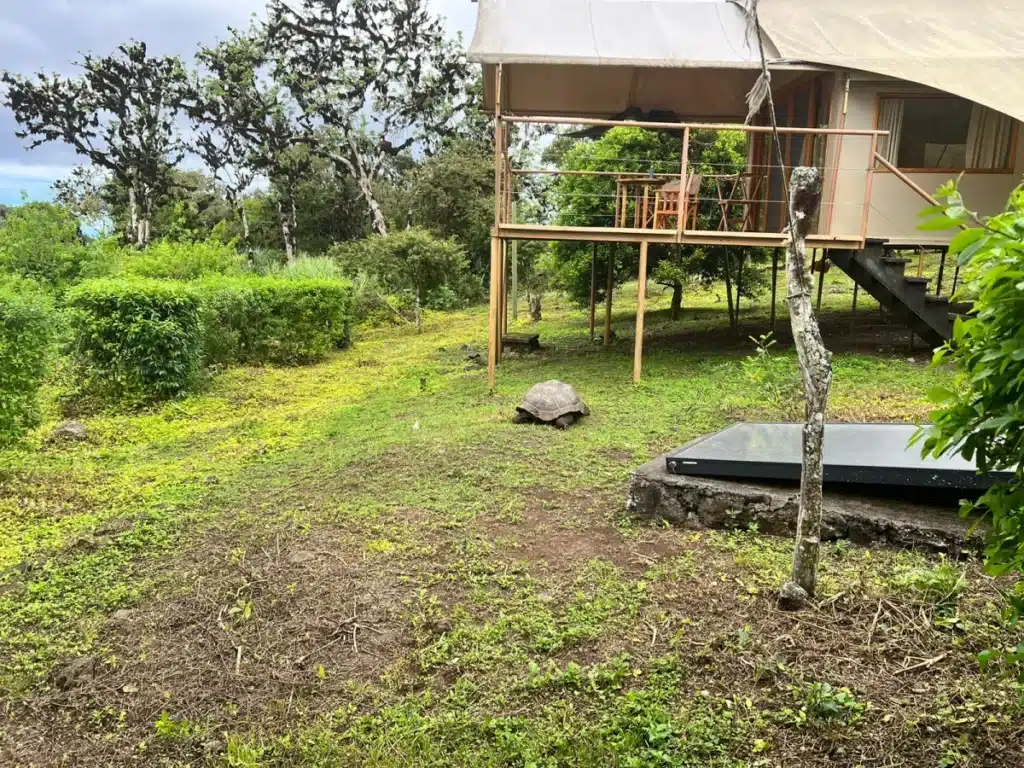
Giant tortoises are often spotted grazing under our Safari Tents
Wildlife seen at Galapagos Safari Camp
In the highlands, where our camp is located, the rains revive the flora and fauna and bring a flurry of wildlife activity to the camp and surrounding area.
Giant tortoises are frequently seen (and heard!) shuffling under our Safari Tents while mockingbirds sing to guests at breakfast.
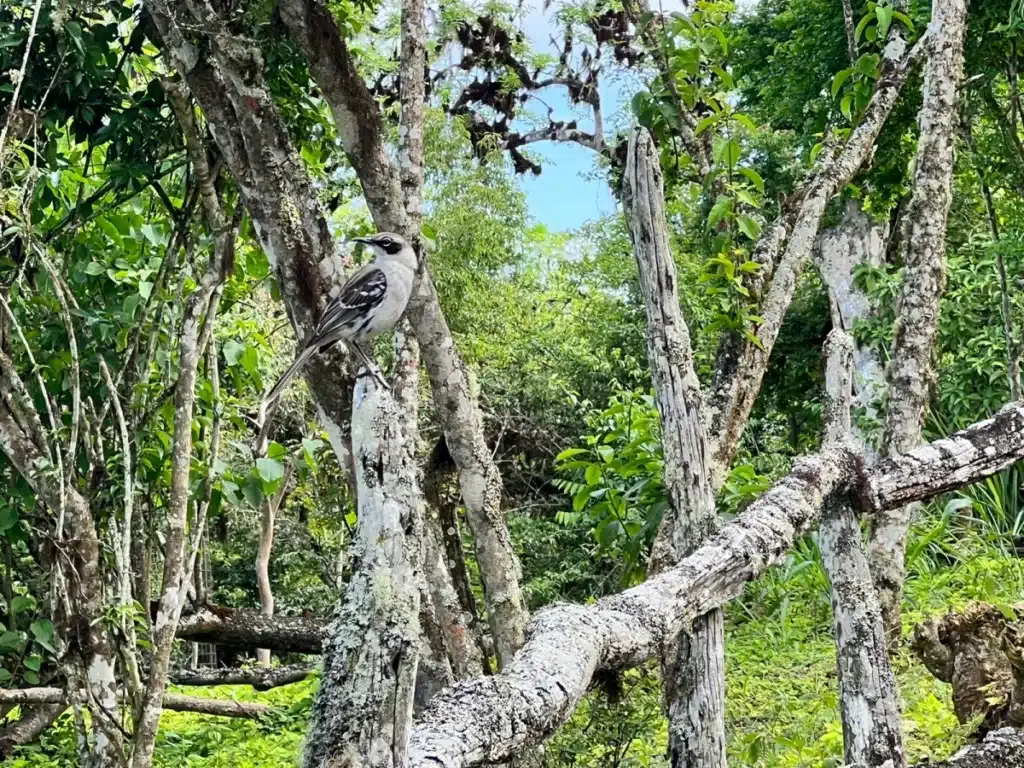
A Galapagos mockingbird sings to our guests at breakfast
Weather at Galapagos Safari Camp
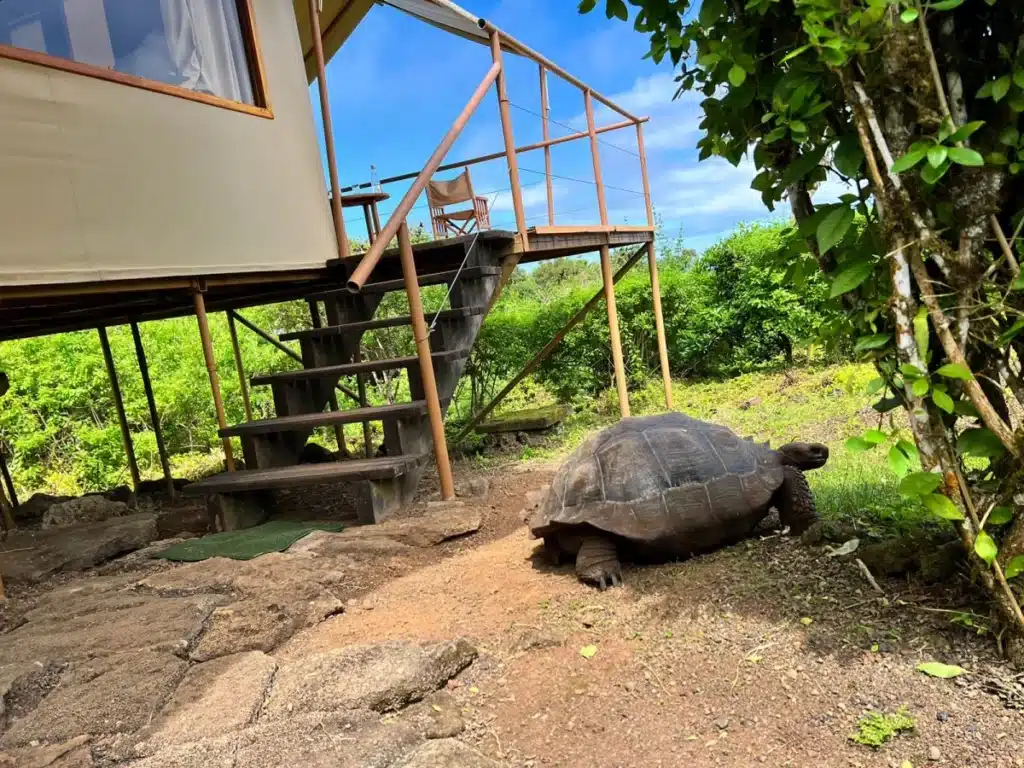
The air is slightly cooler in the Galapagos highlands than at the coast making it more comfortable
At this time of year humidity levels are climbing, particularly on the coastline. As Galapagos Safari Camp is located in the highlands of Santa Cruz, it benefits from cooler evenings and nights, making it more comfortable to dine outside, and sleep without the need for air-conditioning.
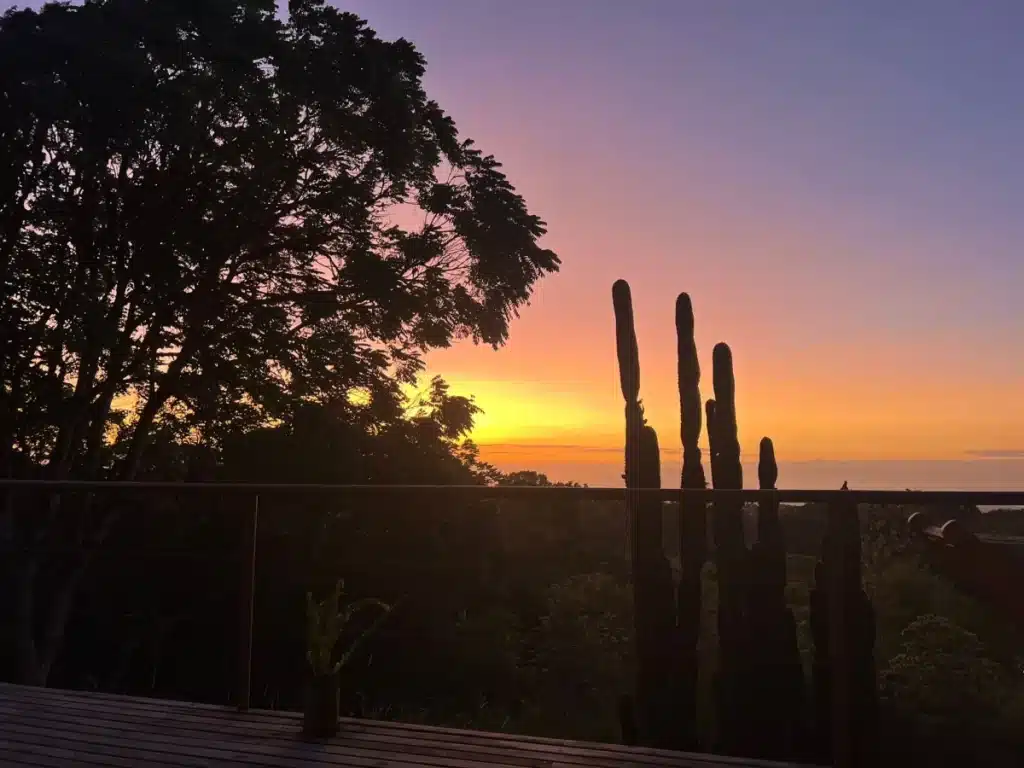
Sunset, captured from the Family Suite at Galapagos Safari Camp
Sunsets are also spectacular at this time of year. Order your favourite cocktail and witness the sun dropping over the national park and distant islands at the end of each day.
Summary: Galapagos in January
January in the Galapagos is a time of increased activity and richness in wildlife, offering visitors the opportunity to witness many of the islands’ creatures as they adapt to the changing season. The mix of breeding activities, feeding strategies, and the lush environment make it an wonderful time for wildlife observation.
January Reviews of Galapagos Safari Camp
The following are comments from guests who stayed at Galapagos Safari Camp in January.
Collected from feedback forms:
“I wish I could come up with something that could be improved upon”
“The guide was very buttoned up and kept us on task”
“Allowable downtime. PERFECTION”
“Everything was exceptional!”
“We have had the best time and will come back again. Thank you for everything.”
“This place was amazing and the staff was incredible”
“I did not want to leave!”
“Really well organised guides. Very knowledgable”
“Everyone was incredibly kind and professional”
“Wonderful. Best trip we ever took!”
“Paola and Andrea were great! They helped us book the trip perfectly!”
“If we could give higher ratings [than 5/5] we would. The staff took great care of us and they are all amazing!”
“[Name of guide] was an excellent guide”
“Everyone went above and beyond attention to detail”
“Our guide and drive were excellent”
“A piece of paradise in Santa Cruz Island. Thank you for the lovely stay”
“[Name of guide] was extremely personable engaging and knowledgable. Wonderful guide”
“All the staff were amazing! Friendly and helpful at hospitality. Food was incredible.”
“I liked it so much that I plan to come back”
“[Name of guide] made the tour very interesting. He went above and beyond to help us with lost luggage. Everything went seemlessly. I will be back”
“So accommodating with dietary needs and preferences. Could not have been more delicious”
“[Name of guide] was lovely to spend time with and very knowledgable. Juan gave us superior service and education about food. Great bread!! We had the best time. Greatest meals, most wonderful staff. Thank you!”
“Exceed our expectations. Quick response to changes in Quito. Felt safe. Will happily tell friends how special this was”
“This place is amazing and unique. Thank you!”
“GSC is a very unique place. Not just because of the location and set up but because of its people. Kind, professional and hard working”
“Food is highest quality and gourmet cooking experience was superb”.
“Javier is outstanding!! [Guide] communicated very well. Knowledge is beyond my expectations. So satisfied with the overall activities”
“Excellent. Staff was outstanding. Guitar entertainment by Jorge – fantastic”
“[Name of guide] was truly exceptional! Excursion towels are awesome (should stock as souvenirs in store)”
“Amazing – excellent variety! [Name of guide]’s wealth of knowledge was such a great learning experience.
“Delicious food and refreshing beverages”
“[Name of guide] treated us well. Thank you from the bottom of my heart”
“An incredible place. The people, the food, the lodge!! Everything was 1st class. Love this place!!”
“The food was excellent! We had a 5 star experience from start to finish!”
Tripadvisor & Google Reviews of Galapagos Safari Camp
For more testimonials, see our reviews on Tripadvisor (you can filter them for ‘time of year’) and also on Google.
When to Visit the Galapagos by Month:
January, February, March, April, May. June, July, August, September, October, November, December.
Wildlife Observation Disclaimer
Please note that our wildlife observations and insights are gathered from the first-hand experiences of our staff, guests, and professional Naturalist Guides. Our goal is to provide an authentic and immersive wildlife experience. However, it is important to recognize that wildlife encounters are by nature unpredictable. Therefore, we cannot guarantee the sighting of specific species or certain animal behaviors on our Safari tours. Each experience is unique, and we appreciate your understanding of the variability and spontaneity of wildlife interactions.
